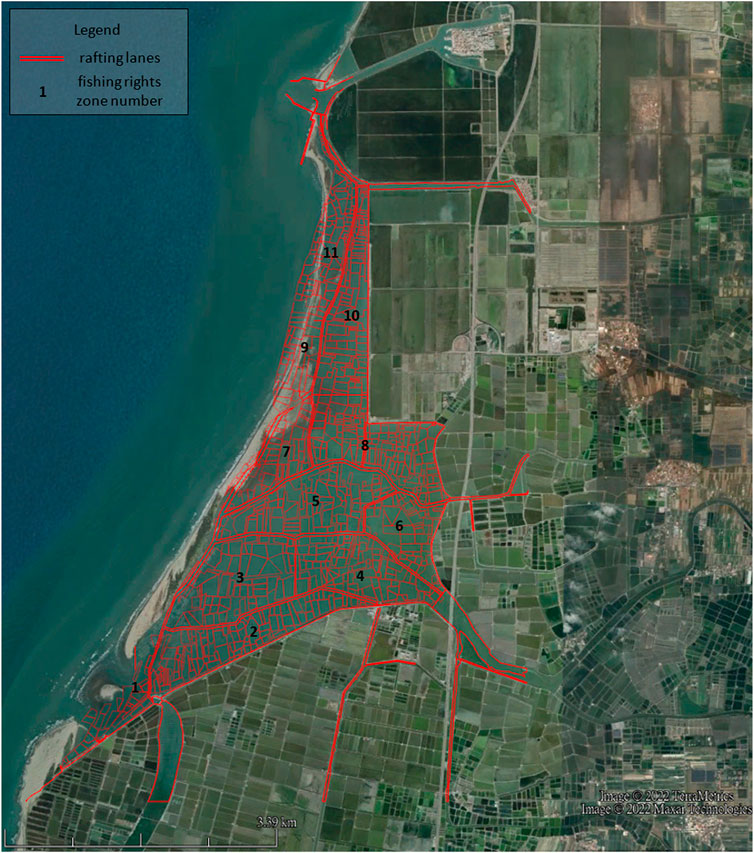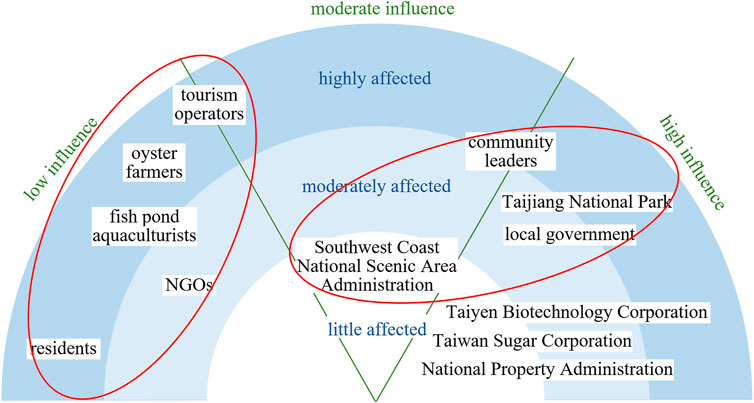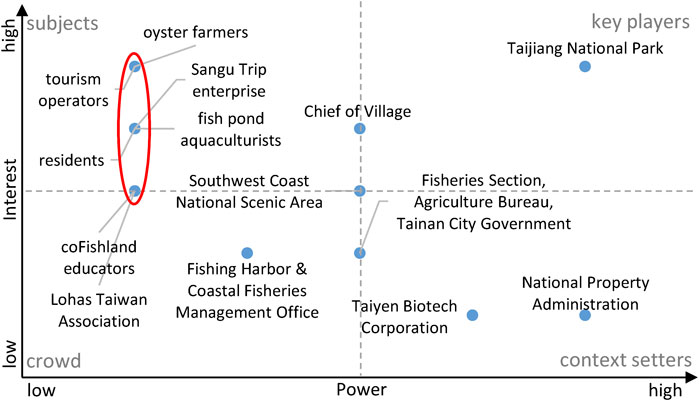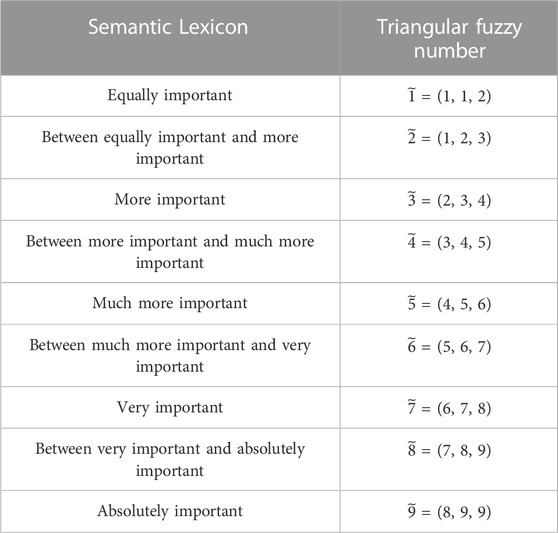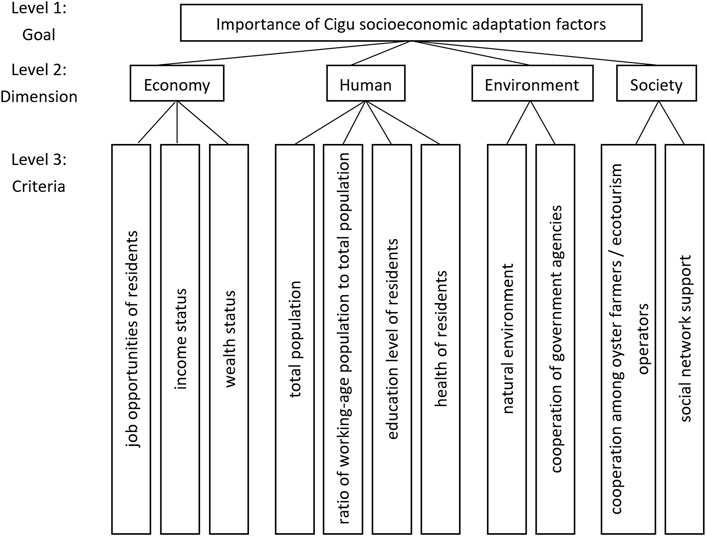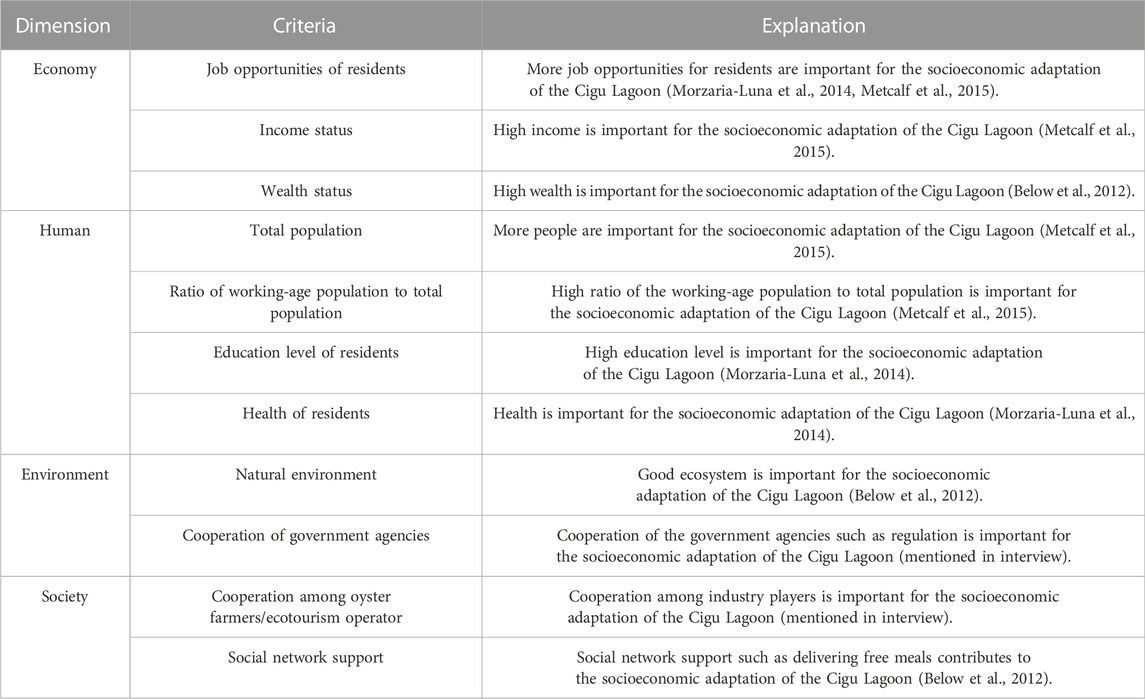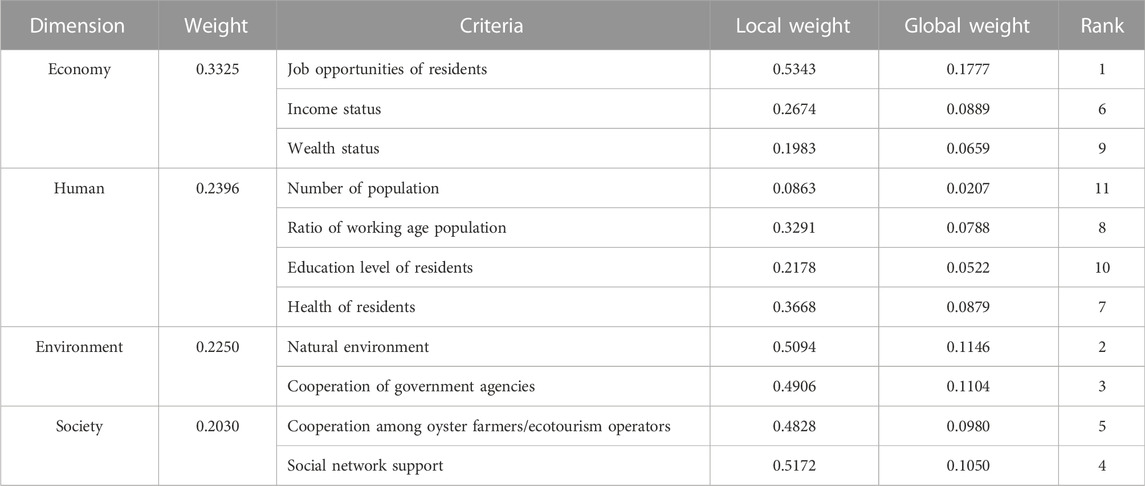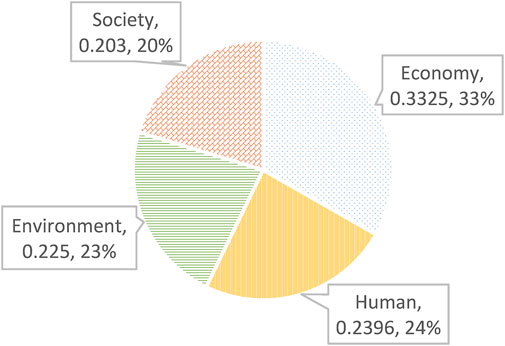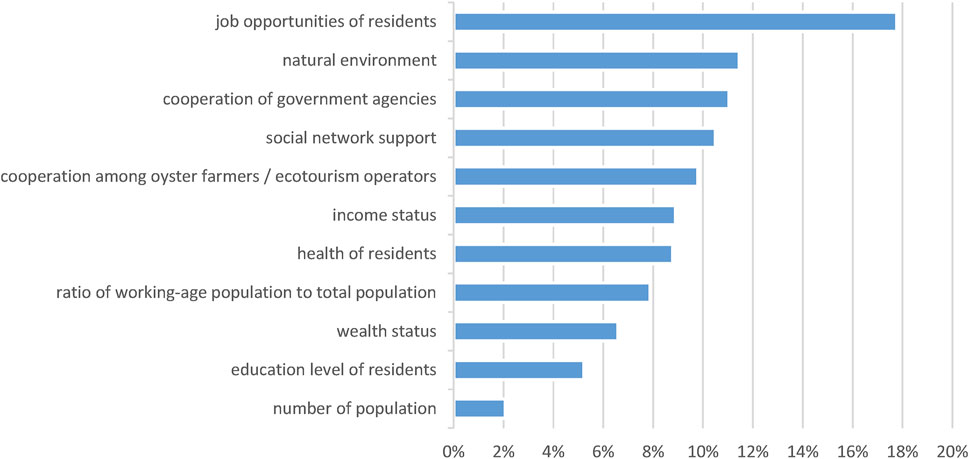- Department of Marine Environment and Engineering, National Sun Yat-sen University, Kaohsiung, Taiwan
Coastal erosion in the lagoon systems is concerned as they are dynamic landscapes, often highly productive and beneficial to humankind. Cigu Lagoon contains rich and diverse ecosystems ranging from mangroves to salt fields, and from fish to birds (e.g., endangered black-faced spoonbill). As well as forming part of the country’s natural defenses against typhoons and storm surges, it is also economically important for oyster farming, fish-pond aquaculture and ecotourism. However, with the construction of reservoir, fishery harbors and breakwaters, sediment transport decreases and sand barrier islands have eroded, narrowed, lowered and moved landwards. Cigu is a rural area with decreasing, aging population, becoming a “super-aged society” as defined by World Health Organization. Therefore, it is imperative to study the socioeconomic impacts of these changes, and then to explore critical adaptation factors and potential adaptation strategies. In this research, we conducted interviews and a fuzzy analytic hierarchy process survey. Diverse stakeholders were identified and mapped using a stakeholder rainbow diagram and a power–interest grid. The results show that stakeholders consider the economy to be the most important adaptation factor, especially in relation to the employment opportunities. There are some forms of livelihood diversification in Cigu. Collaboration among young entrepreneurs is the key to socioeconomic adaptation. These factors and strategies may foster socioeconomic adaptation to coastal erosion or geomorphological change, to be aggravated by climate change and other stressors.
1 Introduction
Coastal erosion is becoming increasingly challenging to manage as a result of the impacts of climate change, such as sea level rises and extreme weather events. Coastal erosion in barrier island–lagoon systems is particularly pronounced as they are dynamic landscapes that are beneficial to humankind. They provide a range of natural services, habitats for diverse ecosystems economic benefits and social values. Barrier islands protect the inner coasts from cyclones, storm surges, strong winds, waves and tides. Along the edge of lands and waters, the productivity of the coasts is high. Lagoons increase further productivity of the coasts with habitats like mangroves, salt marshes and seagrasses. The ecological, economic and social importance of lagoon systems are well known (Anthony et al., 2009; Newton et al., 2014).
Lagoon systems are sensitive to geomorphological change; thus, the economic and social systems built on them are also vulnerable. Conservation of these rich ecosystems and the wise use of wetlands (e.g., fisheries, oyster farming, find pond aquaculture, salt extraction, ecotourism, navigation, and port activities) (Ceia et al., 2010) are concerned land use topics as wetlands are not wastelands.
This is the case for the Cigu (Qigu/Chiku/Chi-ku/Chigu/Chi-gu) Lagoon, the largest lagoon in Taiwan. The area around Cigu Lagoon comprises a variety of ecosystems from mangroves to salt fields, and from fish to birds. Cigu salt-pan was formerly the largest salt-drying area in Taiwan. Over half of the black-faced spoonbill population, a critically endangered bird species, migrates to the Cigu area during the winter months. Therefore, Cigu Salt-pans Wetland was designated a wetland of national importance by Taiwanese government in 2007. It is also part of the Taijiang National Park that has been established since 2009. The sand barrier islands comprise a Special Landscape Area of the Taijiang National Park. The protected area offers ecosystem services and societal goods (Marcos et al., 2021). The sandbar-protected water of the Cigu Lagoon is economically important for aquaculture and intertidal fisheries. Oyster farming provides livelihoods for the local oyster farmers and oyster supply-chain workers, while maintaining water quality, nutrient cycling, habitats for other organisms, some shoreline defense, sediment stabilization and carbon sequestration.
There are also many fish ponds around the area for aquaculture. Historically, the land of Cigu was largely created by deposition of sediments. As the newly created land has no source of groundwater, the aquaculture in Cigu lacks fresh water to regulate salinity. Thus the aquaculture here is mainly in brackish water and in lower density, avoiding overdrafting of fresh water and its associated groundwater depletion and land subsidence, if compared to other aquaculture areas in Taiwan (News&Market, 2022). The aquaculturists change the water of the fish ponds by sensing the tide, that is, replace the water through the cycle of rising and falling tides twice a day in the lagoon and along the waterways (CivilMedia, 2022). The constraint of fresh water compels the Cigu aquaculturists to develop polyculture, like hard clam polyculture with milkfish or shrimps. The fish ponds attract many kinds of birds, shaping rich ecosystem. The oyster farming purifies the nutrient outflows from the fish ponds for oysters’ filter feeding before discharging the water to the outer sea. These form a benign socio–ecological system, a special case of the coupled human–environment system (Turner et al., 2003). Cigu’s aquaculture is unique as a potential environmental-friendly aquaculture model in Taiwan. They are substantial carbon sinks too (Lin et al., 2015).
The Cigu area is located in the Southwest Coast National Scenic Area. Its unique landscape of sand barrier islands and lagoons, rich and diverse ecosystems, as well as fisheries, aquaculture and the traditional salt-making industry, have been developed into an ecotourism site. With regional drainage systems connected, Cigu Lagoon plays a role in flood control for neighboring districts. Moreover, barrier islands protect Cigu’s inner coast from strong winds, waves, tides and storm surges caused by typhoons (tropical cyclones). They also act as a buffer against rising sea levels and coastal erosion (Ulm et al., 2016).
In the recent decades however, due to the construction of reservoirs, fishery harbors and breakwaters, its sand barrier islands have eroded, narrowed, lowered in elevation, drifted landwards and changed shape. When the elevation of a sand barrier is not high enough, overwash can occur, moving sands into the lagoon during a storm or typhoon, as shown in Figure 1. Some of the oyster frames circled in red have been affected and may no longer be farmed due to covering or reduction in depth. The silting of the lagoon also hinders local communities and tourism operators from navigating the lagoon even using flat-bottomed rafts (NCKU, 2017). These affects the local livelihoods. Many human and material resources have been used for dredging and constructing hard defenses to protect the lagoon, but the geomorphological change continues. These protection adaptations are also expected to be futile against the effects of climate change, such as sea level rise, and the increasing frequency and intensity of extreme weather events. Thus socioeconomic adaptation is required.
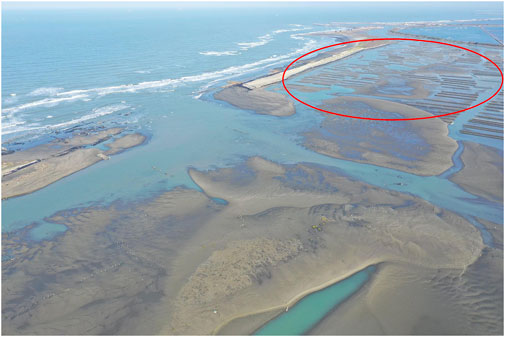
FIGURE 1. Overwash that occurred after peripheral circulation of Tropical Storm Lupit and a strong south-westerly flow in August 2021.
Cigu District around the Cigu Lagoon is a rural district with a decreasing, aging population. The population over 65 years old exceeded 20% of the total population in 2018, becoming a “super-aged society,” as defined by the World Health Organization. Geomorphological changes and the decreasing and aging population around Cigu Lagoon are typical in southwestern coastal areas in Taiwan, such as Waisanding Barrier Island and Beimen Lagoon (Hsu and Pan, 2004). Previous studies have been more focused on the engineering protection (hard- or soft-erosion controls) perspective, using historical maps, satellite-derived images or actual measurements on site (Chien et al., 2006; Lin, 2011; Wu et al., 2013; Lin, 2016; Chang et al., 2018; Lin and Liou, 2018). There are fewer studies on the socioeconomic adaptation to these changes.
The background information leads to the following questions: 1) What are the socioeconomic impacts of the geomorphological changes of Cigu Lagoon and its barriers? 2) How could people adapt to these changes (existing and potential adaptation strategies)? 3) What are the important factors in the socioeconomic adaptation that can inform policymaking?
Therefore, this exploratory study aimed to examine the socioeconomic impacts of geomorphological changes, important adaptation factors, and existing and potential socioeconomic adaptation strategies, using interviews and a fuzzy analytic hierarchy process (FAHP) survey. Diverse stakeholders were identified and mapped using a stakeholder rainbow diagram and a power–interest grid. The results are expected to serve as a reference for government and stakeholders. This can illuminate the socioeconomic adaptation to coastal erosion in other lagoon systems or coastal areas, in addition to proposed structural erosion controls (hard or soft) or future planned retreat (Oppenheimer et al., 2019; Haasnoot et al., 2021). Previous protection-focused adaptation has not considered the issue of maladaptation, climate-resilient development and overall sustainable development (IPCC, 2022). Studying local autonomous adaptation may offer opportunity for collaboration of the government to enhance existing adaptation (Rahman and Hickey, 2019).
2 Study area
The southwestern coast of Taiwan is characterized by tidal flats, sand barrier islands, lagoons and coastal dunes (Lin, 1996). There are three sand barrier islands lying outside the Cigu Lagoon and forming the lagoon area; from north to south, these are Chingshan-Port Sandbar, Wan-tzu-liao Sandbar and Ding-tou-er Sandbar.
From 1966 to 1989, the overall beach line of the barrier islands retreated by around 280 m, or on average, 12 m/year (Chien et al., 2006). Large-scale land reclamations were carried out between the 1940s and 1960s. Reservoirs, check dams and weirs were constructed in the major rivers nearby. After the breakwaters of Chingshan Port’s Southwest Channel were completed in 1994, the change in the average receding distance of the beach line accelerated. Between 2000 and 2005, the beach line of the Chingshan-Port Sandbar retreated by around 140 m, or on average, 28 m/year; the beach line of the Wan-tzu-liao Sandbar retreated by around 50 m, or on average, 10 m/year; the beach line of the Ding-tou-er Sandbar retreated by around 60 m, or on average, 12 m/year. The construction of fishery harbors has also blocked coastal sand transport (WRA, 2019).
These anthropogenic actions have changed the balance of sediment transport along the coast. The lagoon has become shallower and smaller. Satellite-derived images show that the water area of the lagoon declined from approximately 1,300 ha in 1993 to 930 ha in 2013, a 28% decrease from the previous decade (Chang et al., 2018). The shoreline changes of the Cigu Lagoon’s sand barriers can be seen in Figure 2.
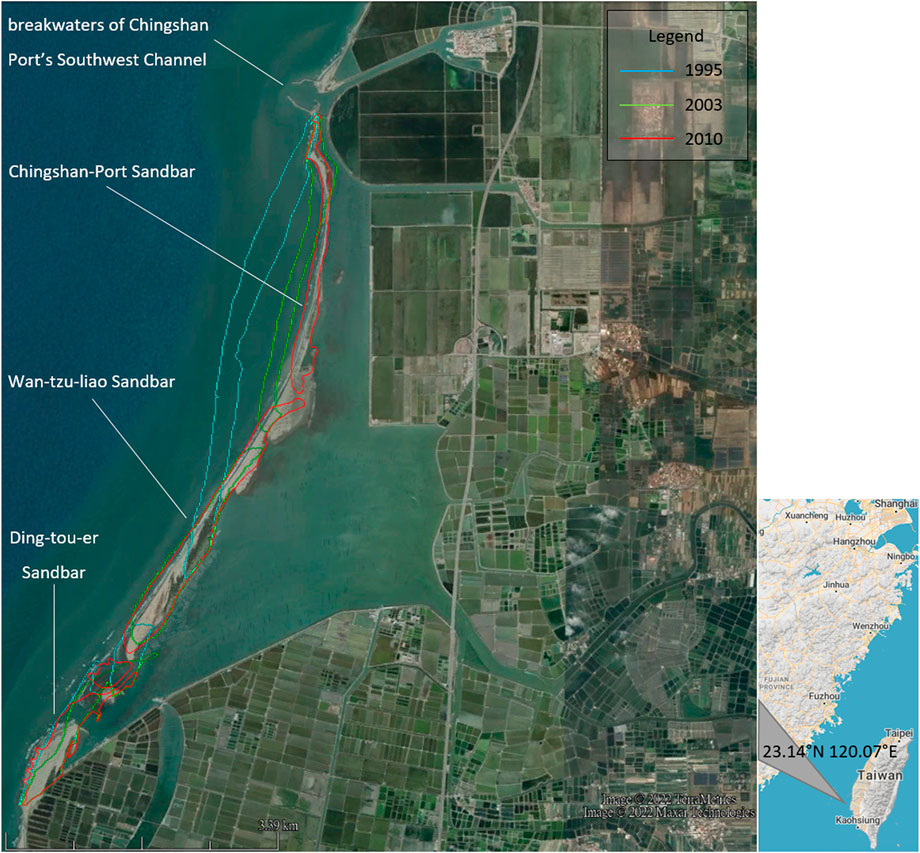
FIGURE 2. Map showing shoreline changes to Cigu Lagoon’s sand barrier islands over the years (underlying satellite image is from 2022).
With reduced sands from the sources, it is expected that this trend will continue and the lagoon will dwindle to two-thirds or one-half of its size in the near future (Lin and Liou, 2018); it may even disperse into an open shoal (Chang et al., 2018). Since the inland-side shoreline of the lagoon is fixed by a cement seawall, landward shifting of the sandbars reduces the size of the lagoon. The registered area for oyster aquaculture was at maximum of 983 ha in 1993, but shrank to 135 ha by 2010 (Chang et al., 2018).
Cigu Lagoon is the first in Taiwan that has measured fishing rights zones for oyster aquaculture. Figure 3 shows the fishing rights zones and rafting lanes (waterways for oyster farmers’ rafts and ecotourism recreational rafts to navigate) in Cigu Lagoon. Note that at least Zone 1, 7, 9, and 11 are affected by the inshore-ward movement of the barrier islands. Some of the rafting lanes are also affected. The existing pattern of regional aquaculture, ecotourism and fishery has to change accordingly.
3 Materials and methods
We used qualitative and quantitative methods for triangulation due to limited information, potential bias and poor data. These included literature review of the study area, one author staying in the field, direct field observations to explore the Cigu Lagoon site and local communities, identifying and becoming acquainted with stakeholders, conducting interviews and completing an FAHP questionnaire survey with the stakeholders.
3.1 Literature review
3.1.1 Studies on the geomorphological change of Cigu Lagoon
The government of Tainan County began to recognize the erosion of sand barrier islands in the 1990s and constructed hard protection structures. Researches were also carried out to evaluate the effectiveness of different engineering approaches. In 2005, NCKU Hydraulic and Ocean Engineering R&D Foundation measured depth of the lagoon, surveyed wave and current, sampled sand and investigated the trend of sand transport (Chien et al., 2006). The information was then used to design soft protection strategies for sand barriers of the lagoon.
With the establishment of Taijiang National Park, more resources are put into research to preserve sand barrier islands of the Cigu Lagoon. Lin (2011) studied evolution of the lagoon and barriers based on literatures, aerial photos and satellite images, measured height and substrate of sand barriers and conducted field interviews. He only mentioned briefly some impacts of the lagoon’s evolution without further elaboration. Wu et al. (2013) compared maps and measured topography and substrate of sand barrier islands before and after typhoon season in 2011 to check overwash area.
Chang et al. (2018) analyzed coastline changes of Cigu Lagoon between 1974 and 2015 using a series of satellite-derived images. They developed a lagoon evolution model and suggested that Cigu Lagoon may disappear in the future. Lin and Liou (2018) focused on the Chingshan-Port Sandbar and Wan-tzu-liao Sandbar to investigate different parts of the sand dunes and assess vulnerability of the dunes. They found that the Chingshan-Port Sandbar and northern part of the Wan-tzu-liao Sandbar are vulnerable.
There are many engineering works carrying out to stabilize the precarious landscape (Lin, 2016). From the construction of hard structures like breakwaters to soft engineering measures like geotextile tubes, sizeable human and material resources have been devoted to the technical solutions. Nonetheless, the Chingshan-Port Sandbar is still eroding, narrowing, lowering and moving landwards, and the size and depth of lagoon still decrease (Lin and Liou, 2018). There is limit to technical measures against reduced sands from the sources. Lin and Shen (2019) suggested to plan coastal setback zone in Taiwan coastal area and surveyed public opinion on the suggestion. They found that more people accept coastal setback zone and even planned retreat if the government has planned appropriately in advance and provided financial aid to retreat. But managed retreat requires high societal acceptability and has high lead time (e.g., 25 years), needs to be planned early as part of the adaptation pathways until crises recur and society accepts (Haasnoot et al., 2021). In the meantime, besides engineering works to delay the erosion and silting to buy time, socioeconomic adaptation should be on the radar to reduce harms.
Despite the geomorphological change is a well-aware issue in decades, the action mainly depends on the government to carry out engineering projects for protection except the Lohas Taiwan Association. This civil society organization organizes landscape preservation activities for volunteers to join as well as monitors changes of sand barrier islands regularly. But they are the minority. Other local residents may not prepare for it and have no plan. Many of them let things take their own course even though their livelihoods are affected.
3.1.2 Local socioeconomic context
Cigu is part of the Salty Region of Taiwan. The soil of the western Cigu around the Cigu lagoon is too salty for general farming. Crops suitable include onion, garlic and muskmelon but limited production. After the completion of Kanan Irrigation System, some areas of the southeastern part of Cigu were acquired to plant sugarcane but ceased production now by the Taiwan Sugar Corporation (Hsu, 2010).
Hence, traditionally most of the residents fished for a living. The main economic activity is aquaculture. Saltwater fish ponds were opened up to rear milkfish conventionally, switched to tiger prawn during 1980s. Mass mortalities by the outbreaks of infectious diseases triggered the collapse of tiger prawn cultivation since 1987 (Hsu, 2010). And now the main aquaculture includes hard clam, milkfish, grouper, grey mullet, white shrimp, tilapia, snubnose pompano, and oysters in the lagoon.
Cigu’s large scale salt-making industry began under Japanese rule. Salt ponds, or salterns, were created for solar evaporation of brine to extract salt. Cigu salt-pans became the biggest salt field in Taiwan. In response to the aging of labors and competition of cheaper imported salts, Taiwan Salt Company attempted to mechanize the harvest operation in 1986, but failed to continue in 2002. Taiwan’s salt-making industry was then consigned to history. There are now few manufacturing factories in Cigu, mostly small processing plants (Hsu, 2010).
The discovery of endangered black-faced spoonbills in Cigu was publicized in 1989. This brought tourism opportunity to Cigu Lagoon (Hsu, 2019). Local oyster aquaculture entrepreneurs began to raft tourists to the Wan-tzu-liao Sandbar, packaged with black-faced spoonbill tour, Cigu Salt Mountain and Taiwan Salt Museum. Taiwan Salt Company was privatized and renamed as Taiyen Biotechnology Corporation from 1995. In 1998, they turned a four-story-high mountain of salt into a famous tourist spot, referred to as “Cigu Salt Mountain.” With the designation of the Southwest Coast National Scenic Area in 2003 and Taijiang National Park in 2009, tourism has become part of Cigu’s industry.
However, Cigu’s population is still decreasing and aging. Figure 4 shows that the population in Cigu District has decreased steadily over the years. The natural increase (births minus deaths) and net migration are both negative. The population over 65 years old exceeded 20% of the total population in 2018, becoming a “super-aged society,” as defined by the World Health Organization (Cigu District Office, 2019).
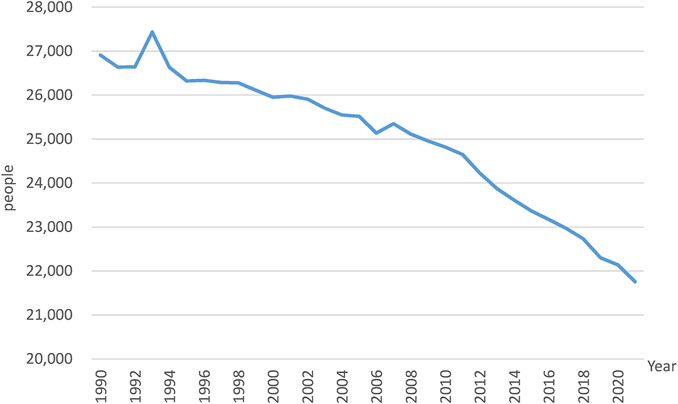
FIGURE 4. Change in the population of Cigu District over the years. Source: Department of Budget, Accounting and Statistics of Tainan City Government.
3.2 Identifying and getting acquainted with stakeholders
The participants were recruited using a purposive or “targeted” sampling strategy (Ryfe and Stalsburg, 2012). The idea of the stakeholder can be traced back to philosophical views about the relationships between individuals and the nature of civil society (Murdock, 2010). The concept appeared in written management accounts in the 1910s (Schilling, 2000) or 1930s (Preston and Sapienza, 1990). Use of the word “stakeholder” for this concept surfaced in the internal memoranda of the Stanford Research Institute in the early 1960s. However, the stakeholder theory first focused on the stakeholders of a corporation (Freeman et al., 2010). With applications in issue-based, policy-oriented project management, the participation of stakeholders becomes central in relation to multi-stakeholder governance. Here, stakeholders are defined as people or organizations who affect or are affected by an issue or implementation of a policy, either directly or indirectly.
The literature review compiled community profiles by describing the local socioeconomic context (Vanclay et al., 2015). A situation assessment identifies broad categories of who has a stake in the phenomenon under investigation by interests or through proximity (Colvin et al., 2016). Stakeholder identification is an iterative process, during which predefined stakeholders are listed based on written records of evidence. A period of staying in the field, and preliminary scoping interviews with experts and local people, helped to further identify stakeholders. Stakeholders were reached out through known contacts, secondary data sources (e.g., newspaper or electronic media reports), online searches, social media, local networking events and snowball sampling (stakeholder-led identification). In the snowball method, people suggest new people who cover the issue better than themselves or who could add weight to their own concerns or standpoints (Gregory et al., 2020). Snowballing was benefited from the goodwill and volunteerism of people to assist further recruitment through their own networks. The process ceased when the saturation point is reached, with no new categories of stakeholder (with different viewpoints) being recommended. This iterative process has the advantage of checking the information collected.
As with other environmental issues, the stakeholders are diverse, with diverse ranges of ages, education levels, occupations/functional roles, personal backgrounds and affiliations [e.g., different communities, public agencies or non-governmental organizations (NGOs)]. This is why the application of a stakeholder analysis in respect of environmental issues, natural resource management or development literature is sometimes called diversity analysis (Reed et al., 2009). In this study, community leaders, oyster farmers, fish pond aquaculturists, tourism operators, residents, NGOs, and local and central government agencies were engaged to improve the representativeness of social viewpoints, bringing alternative voices into the discussion. Geographical origin (different villages), age and gender were also considered.
The stakeholder list was brainstormed using the stakeholder rainbow diagramming exercise (Chevalier and Buckles, 2021). As illustrated in Figure 5, the rainbow diagram places stakeholders according to the extent they can affect, be affected, or be both affecting and affected. The diagram helps to identify who needs to be involved in the inquiry process, as circled in red. Two groups of stakeholders were identified: those who are highly affected but have low influence (oyster farmers, fish pond aquaculturists, tourism operators, residents and NGOs), and those who are moderately affected but have high influence (Taijiang National Park, local government, community leaders and Southwest Coast National Scenic Area).
There are multiple dimensions involved in mapping identified stakeholders, such as interest/need/urgency/importance, power/influence, legitimacy, awareness and level of support/attitude (positive, neutral, negative), which can be arranged in a grid, split into a four-quadrant matrix or classified with a Venn diagram. A graphical representation of the stakeholders was mapped in a power–interest grid. In Figure 6, stakeholders are first distinguished into four-quadrants of subjects (high interest, low power, the “victims”), key players (high interest, high power, the people that can make the difference), context setters (low interest, high power, the “irresponsible”) and crowd (low interest, low power, the “bystanders”); then, positions are adjusted by their relative interest and power.
It transpires that Taijiang National Park is the key player in respect of the socioeconomic adaptation to geomorphological change in Cigu Lagoon. Special attention is given to the low-power, highly-interested (having the most at stake) stakeholders circled in red because they are vulnerable but usually low in visibility. They can easily be marginalized.
3.3 Fuzzy analytic hierarchy process (FAHP)
Multiple Criteria Decision Making (MCDM) is capable of problem structuring and preference modeling, which aims to support decision making in complex problems with multiple factors or criteria to be considered (Govindan and Jepsen, 2016). One of the most popular MCDM methods, the analytic hierarchy process (AHP), is a semi-qualitative method that converts humans’ subjective judgements into numerical ratings; thus, a numerical eigenvector for the priority order can be obtained (Saaty, 1980). Since the logic of people’s thinking is typically fuzzy, the purpose of FAHP is to solve semantic fuzziness and uncertain judgment problems when respondents are deciding the relative importance in a conventional AHP (Dubois and Prade, 1978).
In this study, the concept of a triangular fuzzy number was adopted to replace the pairwise comparison of AHP (Chen and Hwang, 1992). Geometric means were then applied to calculate the fuzzy weighting. For the FAHP, interval values were applied to replace exact values in the conventional AHP; thus, respondents evaluated problems using a user-friendly scale and made reasonable comparisons during the questionnaire process.
The implementation procedure of the fuzzy pairwise comparison matrix was as follows. Triangular fuzzy numbers were extracted through the transformations described in Table 1 to convert respondents’ opinions. If a conventional judgment matrix
where:
⊗: Multiplication of fuzzy numbers
⊕: Addition of fuzzy numbers
After compiling and calculating the fuzzy numbers for each indicator’s weight, the fuzzy weights were defuzzified to yield crisp weights, which were then normalized to yield a set of comparable weights for the indicators. The center of gravity method was applied to defuzzify weighting values as in Eq. 3. The weighting value of each indicator
3.3.1 Building FAHP structure
The FAHP structure was constructed based on the sustainable livelihood approach (Chambers, 1986) or circle of capacities (Wisner et al., 2011) framework used in the adaptation studies. Sustainable livelihood approach considers the influence of environment factor in the development studies (Chambers, 1986; WCED, 1987; Chambers and Conway, 1991). It is employed by a number of major international development agencies such as United Kingdom’s Department for International Development, CARE (Cooperative for Assistance and Relief Everywhere) and United Nations Development Programme (UNDP) for development. Drawing from the economic metaphor, tangible and intangible livelihood assets are viewed as the “capital” base from which various productive streams are derived to construct livelihoods (Scoones, 1998). IPCC assessment reports called them “livelihood capitals” (Birkmann et al., 2022) or “livelihood assets” (Olsson et al., 2014), and the circle of capacities in the Wisner et al. (2011), and Rampengan et al. (2014) called them “resources.”
Natural capital includes natural resources and environmental services (DfID, 1999). Financial capital contains cash, savings, other economic assets and access to credit/debt. Human capital comprises the skills, knowledge, ability to labor, good health and physical capability when pursuing any livelihood strategy. Social capital is the social resources (e.g., social claims, social relationships, affiliations, associations, networks) upon which people draw to pursue their different livelihood objectives that require coordinated actions. Physical capital encompasses infrastructures and equipments (e.g., house for dwelling, electricity supply, boat) to support livelihoods (DfID, 1999; Badjeck et al., 2010).
The relationship between sustainable livelihood approach and vulnerability/resilience was well acknowledged (Below et al., 2012; Metcalf et al., 2015). Aswani et al. (2019) argued that the sustainable livelihood approach forms the core element of adaptive capacity. Social capital and natural capital is part of the adaptive capacity in Whitney et al. (2017) and Bennett et al. (2014). The New Zealand government utilized also the concept of multiple capitals in their Living Standards Framework for sustainable development and building resilience (Frieling and Warren, 2018).
The hierarchy was divided into three tiers (Figure 7). The first layer is the goal of the FAHP survey, to rank the “importance of Cigu socioeconomic adaptation factors.” The goal was subdivided into four dimensions, namely, economy, human, environment and society. They are the livelihood capitals considered important by the local people during field study. The third level comprises the criteria under each dimension, identified from literature (Below et al., 2012; Morzaria-Luna et al., 2014; Metcalf et al., 2015) and preliminary inputs from the locals. Table 2 shows the descriptions of the criteria explained to the participants of FAHP survey.
3.3.2 FAHP survey and interviews
Once the hierarchical structure was formulated, the FAHP questionnaire was designed in the local language. Questionnaires were completed by one person in each stakeholder organization based on availability and self-selection. Questions or terms that might be ambiguous to the participants were clarified in the face-to-face survey.
A semi-structured approach to the interviews was adopted to create some structure across the interviews while allowing interviewees to respond in the manner or sequence of their choosing (see Supplementary Material for the translated interview questions). Conversations were tape-recorded if the interviewee did not refuse or appear uncomfortable in its presence. Audio recording was useful as one of the interviewers is not an expert speaker of the Taiwanese language.
The interviews and FAHP survey were conducted with a Chief of Village, an oyster farmer, a tour guide, tourism start-up entrepreneurs (Sangu Trip enterprise), a fish pond aquaculturist, an industry entrepreneur, education start-up founders (coFishland educators), NGO founders (Lohas Taiwan Association), section chief of the Taijiang National Park, station head of the Southwest Coast National Scenic Area, an associate technical specialist of the local government’s Fisheries Section, and officers of the Fishing Harbor & Coastal Fisheries Management Office. A total of 12 questionnaires were completed but one did not pass the consistency test, so the number of valid questionnaires was 11. Collected data were analyzed using Power Choice v2.5. Aggregations of individual judgments were pooled by geometric mean.
4 Results
To understand physical change of Cigu Lagoon and barriers, documentary reviews found that there was lack of historical monitoring data series regarding depth and area of the Cigu Lagoon, and area, height and volume of its sand barrier islands. For confirmation, by walking from Chingshan-Port Sandbar to Wan-tzu-liao Sandbar (before the bridge to Chingshan-Port Sandbar was closed for demolition in October 2020), we observed that the Chingshan-Port Sandbar has largely become artificial sand dike instead of natural sandbar. The northern part of the lagoon becomes so shallow until people can walk across the lagoon to sand barrier island during low tide. The immediate impact is that the northern part of the lagoon has less space suitable for oyster aquaculture. Besides, some silting areas in the lagoon are too shallow for overturned rack/horizontal hanging method, which requires only the lowest depth.
4.1 FAHP survey
The computed pairwise comparison matrices for each level are given in Table 3. Via the prioritization process, the overall composite weights of each dimension and criterion are summarized in Table 4.
Weights of the dimensions in Table 4 are redrawn in the pie chart in Figure 8 to visualize their share. The most important dimension is economy (33%). However, human, external environment and social factors still play non-negligible roles (>20%) for Cigu socioeconomic adaptation.
When breaking down dimensions into criteria as displayed in Figure 9, job opportunities of the residents (17.8%) stands out as the most important criterion for Cigu socioeconomic adaptation, leading to a large margin compared to natural environment (11.5%) and cooperation of government agencies (11%), the second and third most important criteria. These are followed by social network support (10.5%) and cooperation among oyster farmers/eco-tourism operators (9.8%). The top five criteria occupy more than 60% of the weights.
4.2 Interviews
We first interviewed Professor T.-Y. Lin, a marine geography expert who is familiar with Cigu Lagoon. He suggested that the cemented Cigu Salt-field Seawall should be dismantled to restore its natural inland-side shoreline. Then the inshore-ward movement of the sand barrier islands will not be eroded when they reach the inner coast of the lagoon, still can function as natural coastal defense in some degree.
Interviews with stakeholders provide more understanding regarding the results of the FAHP survey. Interviewees indicated that the most significant socioeconomic issue in the Cigu area is population aging, followed by income instability and decrease in population. Stakeholders believe that the population is decreasing and aging because young people have difficulty finding jobs if they do not inherit oyster aquaculture’s fishing rights zones or fish pond land, or have strong capital to start a business in the area. Without employment opportunities, young people leave Cigu to migrate to urban areas.
One interviewee commented that the income from aquaculture is unstable as it is primary sector of the economy, which relies on the physical environment and ecosystem. The water temperature of the lagoon is rising, which is attributed to a smaller and shallower lagoon and climate change. Harvests from intertidal fisheries have deteriorated, although these are not the primary source of income for the aquaculturists in the area. Interviewees reported that catches using Taiwanese Seine were not as large as they had been in the past, that fishers and gleaners (people who collect seafood by walking and gathering) could not reap as much as they did in the past, and that some species that used to swim into the lagoon from the outer sea had disappeared altogether. Eel fry have been harder to catch in recent times.
Currently, the major issue in relation to geomorphological changes to ecotourism is the navigation of recreational rafts. Interviewees remarked that the number of recreational rafting operators has halved from 12 to 6, and the number of actual recreational rafts that are still in active operation has decreased from more than 30 rafts to fewer than 10 rafts. Before recreational rafting operators were hit by the Coronavirus pandemic (COVID-19) in recent years, tourism in Cigu District was already declining.
In Cigu Lagoon, cooperation among oyster farmers or tourism operators is not common. Interviewees told us that they sell their products or market their services separately. This may be due to differing needs, interests, values and aspirations of the various subgroups in different villages.
One interviewee revealed that there are cases of dispute between oyster farmers regarding the fishing rights zones as a consequence of the sandbars’ landwards shift. Currently, local oyster farmers settle disputes themselves without involving the government or courts.
5 Discussion
5.1 Socioeconomic impacts of geomorphological change
The decrease and aging of the Cigu population are common phenomena in relation to urbanization in Taiwan, where people have moved to cities for better access to the labor market, education and healthcare. The production chain of oyster aquaculture offers jobs such as post-processing of the oyster harvest (e.g., shucking), which are labor-intensive. However, the income is neither high nor stable. Most oyster farmers sell their oysters to wholesalers as a commodity. Therefore, the prices of oysters and other aquaculture products suffer from commodity cycles. Without differentiation by branding, they have difficulty in competing with the cheaper and larger scale of aquaculture in other places, not to mention imports from foreign countries.
We were surprised to learn that the water temperature of the lagoon has risen, which is attributed to a smaller volume of the lagoon and climate change. The attributed role of climate change can be investigated further. Regarding the reported decreasing harvests in recent times, geomorphological change in the Cigu Lagoon and barriers reduces the water exchange between the lagoon and the outer sea. Since Chingshan-Port Sandbar and Wan-tzu-liao Sandbar have joined, Cigu lagoon has only one inlet from the outer sea now, between Wan-tzu-liao Sandbar and Ding-tou-er Sandbar. As Ding-tou-er Sandbar is moving toward south, the original floating rack zone sheltered behind Ding-tou-er Sandbar is decreasing in area. More floating racks crowd behind the southern Wan-tzu-liao Sandbar, where the deepest area of the lagoon left, as the highest productivity floating rack demands deep water. This slows down the water flow. Sediments deposit near the inlet. After searching the literature, it was found that the overall dilution capability of the lagoon in 2015 fell by around 50% compared to that in 2012 (Lin et al., 2015). The water exchange of the lagoon is vital to oyster aquaculture. Compared to 1997, the modeled total living biomass, gross efficiency (catch/Net Primary Productivity), Finn’s mean trophic path and oyster annual yield in Cigu Lagoon in 2011 decreased (Lin et al., 2011).
In the past, tourism gave the local economy a boom, for the sector was chiefly consisted of small and medium-sized enterprises, and manpower and materials in use sourced mainly from the local economy. Specifically, seafood restaurants around the Cigu main street contributed 50% to the income multiplier (Hsu, 2019). Besides navigation issue of the recreational rafts, with the erosion of sand barrier islands affecting landscape scenery and changes in the ecosystem affecting biodiversity, the attraction of ecotourism in Cigu Lagoon is expected to be abated.
The dispute cases between oyster farmers over fishing rights zones suggests that geomorphological change may also challenge local institutions or social capital. While local oyster farmers are able to settle disputes themselves without involving the government or courts currently, these conflicts are expected to increase with the squeeze on aquaculture space.
5.2 Socioeconomic adaptation factors
Economy may be rated the most important dimension in the FAHP survey because monetary issues comprise an immediate concern that impacts directly on a household’s ability to meet daily needs or pursue livelihoods, rather than being an indirect human, external environment or social factor. Since it is a rural area with a decreasing, aging population, local residents wish to retain their children by economic growth creating job opportunities for their children; this is their perceived most important criterion in respect of socioeconomic adaptation. The emphasis on economic considerations is in line with another study in Thailand (Bennett et al., 2015), but different from Rampengan et al. (2014) where social dimension is the most important. Recent studies in several South- and Southeast-Asian countries show that adaptation factors are likely country-specific, reflecting local conditions (Brown et al., 2019).
Natural environment was ranked second by the stakeholders, showing that they are aware that a good ecosystem is important for their socioeconomic adaptation. The environmental awareness may be related to the history of Cigu, where there were protests against the construction of the highly polluting Naphtha Cracker No. 7 and Pin-nan Industrial Zone in Cigu (Ho, 2014). This was one of the major environmental movements in Taiwan.
The third most important factor is the cooperation of government agencies such as through regulation. At this time, some members of the younger generation are staying in Cigu and trying to innovate in aquaculture, ecotourism and environmental education. They have mentioned that they need more institutional support to try out new ventures on their entrepreneurship.
Contrary to the expectations, the criteria of “social network support” and “cooperation among oyster farmers/ecotourism operators,” both belonging to the society dimension, were ranked fourth and fifth. The existing cooperation among oyster farmers or tourism operators is weak. We did not expect that stakeholders value the social capital.
The importance of collaboration and institution is inspired by a small-scale shell-fishery example in Uruguay, which has rejuvenated the yellow clam fishery after 14 years of mass mortalities (Defeo et al., 2021). They institutionalized the informal co-management system (collaboration among stakeholders to provide rules and action mechanisms in the formal Local Fishery Council; community participation in the Local Fishery Council through the elected Fisher’s Assembly), assessment and monitoring, enforcement and changed marketing direction. Now, after being sent to a certified local processing plant, fresh clams go to restaurants with chefs as strategic stakeholders. Unit prices are fixed before each fishing season by the local Fishers’ Assembly to prevent conflicts or rent seeking. A tourism initiative package or domestic traceability label increases added value. Effective participation increases fishers’ willingness to collaborate and accumulates local cohesion. However, they have been threatened by increasing seafood imports in the recent years.
5.3 Existing and potential socioeconomic adaptation strategies
Diversifying livelihood is the most prominent existing risk aversion and economic adaptation strategy in Cigu. In the literature, livelihood diversification includes diversification within the aquaculture/fisheries sector (exploiting multiple species), occupational multiplicity/pluriactivity (gaining income from more than one economic activity, e.g., aquaculture and fisheries), occupational mobility (non-aquaculture income stream) and geographical mobility (Coulthard, 2008; Badjeck et al., 2010). Vulnerability could be reduced with more diverse livelihoods, rather than reliance on a single livelihood. In Cigu, some oyster farmers have fish ponds for rearing other aquaculture products. Fish-pond aquaculture involves rearing habitually mixed-in species such as hard clams, milkfish and white shrimp, also taking advantage of their symbiosis. Taiwanese Seines are often used in the lagoon for intertidal fisheries. Aquaculturists catch eel fry in the outer sea during their fishing season. Together with some short-term employment, wage work, service or other self-employed positions, Cigu residents did not fall into a “specialization trap,” where fisher folk rely mostly on one species or activity. Remittances from young people in cities or overseas also top up household income. In contrast to marine fisheries where specialization can promote poverty reduction and wealth accumulation during favorable conditions (Finkbeiner, 2015), aquaculture in Cigu tends to diversify to stabilize income.
However, other diversifications such as the notion to create additional livelihoods through ecotourism or recreational agriculture have been less successful. Shi Nan Agricultural Leisure Area was initiated in Cigu in 2000. Despite having two decades of history, it is still struggling to build a sustainable business model. Likewise, diversifying the sales channels of aquaculture products is also slow. Oyster farmers and fish pond aquaculturists still sell their products primarily to wholesalers, while some sell to restaurants. With the presence of the Coronavirus pandemic threat, online sales of aquaculture products have grown rapidly. Older aquaculturists have endured a steep learning curve to market them online. Policymakers can devise strategies in these directions.
One potential strategy is the integration between ecotourism, local aquaculture products, local agricultural products, leisure fisheries (Cigu is a popular spot for recreational fishing) and local folk cultural activities. Indeed, ecotourism can enhance the competitiveness of Cigu’s aquaculture and agricultural products (Kim et al., 2017). However, their synergy requires inter-industry alliances, connections among the villages and broader regions, and multifaceted interactions. In this sense, ecotourism in Cigu is still in its infancy, lacking the long-term cultivation of human resources and the mechanisms of collaboration.
The aging local population may affect the ability to drive innovation and growth (Schrobback et al., 2014). For example, selling aquaculture products online requires sellers to be familiar with electronic commerce. With the lack of innovative endeavors, more youths have left Cigu and the population has become older. This could be a vicious cycle or a trap that is hard to escape.
Recently, some younger residents who are looking to revitalize Cigu have initiated the Qigu Tide group. One interesting feature of this group is that the members come from different villages of Cigu. One of the government agencies interviewed hopes that the young generations from different villages will have better ties through this group as Cigu’s population and resources are sparse in dispersed villages. This group is a potential seed for Cigu’s socioeconomic adaptation. Compared to the neo-endogenous regional development model in England (Bosworth et al., 2016), the networks of the group and in-migrant entrepreneurs in Cigu are very new and lack local empowerment. The short-term project-based nature of the local action group is flexible but also fragile.
To attract young people to join the aquaculture in Cigu, the issue of renting fish pond lands or oyster farms needs to be addressed. Old aquaculturists have to be open-minded to accept younger generations other than their own children. Supportive mechanisms like “Two Hundred Hectares” project in Yilan (Tsai, 2019) need to be provided.
One option is the anticipated commencement of construction for the Qigu Technology Industrial Park this year. Some Cigu residents hope that it will generate employment opportunities and spur economic and population growth, exemplified by Tainan Technology Industrial Park in the neighboring Annan District. But it has potential to pollute Cigu Lagoon if the emission is not controlled. Hiring of cheaper foreign labor may undermine local labor and lower wages. Influx of new migrants alter the local social structure. In-migration of people to the area may cause rising costs of living. Anyway, young population is unlikely to grow exponentially as population of Taiwan is also decreasing and aging now. Another Cigu Salt Mountain Recreation Area project is to construct hotel and villas near to Cigu Salt-pans Wetland. The costs and benefits to the Cigu communities are to be determined.
Another proposal is to turn Cigu to a large base for environmental education, seeing its rich resources in oyster and milkfish aquaculture (Chang, 2013). But it requires unconventional planning, courses design, the support of public sector, funding for venues and facilities. Financial feasibility for maintenance and marketing needs also a business model.
6 Conclusion
In this paper, we report the field study, stakeholder identification and mapping, interviews and FAHP survey conducted to understand the problem of geomorphological change in Cigu Lagoon and local communities’ socioeconomic adaptation. Erosion and landwards shifting of the sand barrier islands, as well as a smaller and shallower lagoon, affect oyster aquaculture and ecotourism. We are surprised to find that it caused also disputes between oyster farmers over the fishing right zones. In the FAHP survey, the most important dimension of adaptation was the economy. The most important criterion was the employment opportunities of residents. During the interviews, the most concerning socioeconomic issue was population aging. Aging, decreasing population and income instability can result in a vicious cycle that dampens the innovations needed to diversify livelihood or increase the value of aquaculture products by online marketing.
The lack of collaboration between villages in the Cigu District is being improved by the networking initiative of the young entrepreneurs’ Qigu Tide group. A list of diverse stakeholders has been identified through a stakeholder rainbow diagram. Stakeholder mapping using a power–interest grid indicated the importance of Taijiang National Park and a group of low-power but high-stake stakeholders. Collaboration among oyster farmers, tourism operators, fish pond aquaculturists, and local and central governments can strengthen the existing livelihood diversifications, such as marketing aquaculture products through ecotourism and government support.
This exploratory study does have some limitations. The sample size was small, so more powerful statistical analyses cannot be conducted. Despite the small study sample, the focus on diverse stakeholders with special attention to low-power, high-stake stakeholders provide information for forthcoming adaptation planning process. This initial step is to be followed by participatory deliberation processes to involve stakeholders, policymakers and interdisciplinary researchers in adaptation planning and actions for climate-resilient development, from the perspective of holistic sustainable development.
Geomorphological and socioeconomic changes are typical on the southwestern coast of Taiwan, and its socioeconomic adaptation may shed light on socioeconomic adaptation to the coastal erosion in other lagoon systems or coastal areas. This paper contributes to the sparse literature on the adaptation of oyster farming to climate change, economic globalization (imported shellfish) and other stressors. It is hoped that this study can inspire Cigu Lagoon to develop sustainably and serve as an example of adaptation in view of imminent global climate change impacts.
Data availability statement
The original contributions presented in the study are included in the article/Supplementary Material, further inquiries can be directed to the corresponding author.
Ethics statement
Ethical review and approval was not required for the study on human participants in accordance with the local legislation and institutional requirements. Written informed consent from the participants was not required to participate in this study in accordance with the national legislation and the institutional requirements.
Author contributions
Conceptualization, TP and Y-CC; methodology, TP and Y-CC; investigation, TP; writing—original draft preparation, TP; writing—review and editing, TP and Y-CC; supervision, Y-CC; funding acquisition, Y-CC. All authors have read and agreed to the published version of the manuscript.
Funding
This study was funded by the Ministry of Science and Technology of Taiwan (Grant Number: MOST 109-2621-M-110-004).
Acknowledgments
We would like to thank Sheng-Kai Huang, Yu-Sheng Tseng, Howard Liu and Monique Mercado in assisting with interviews and the FAHP survey.
Conflict of interest
The authors declare that the research was conducted in the absence of any commercial or financial relationships that could be construed as a potential conflict of interest.
Publisher’s note
All claims expressed in this article are solely those of the authors and do not necessarily represent those of their affiliated organizations, or those of the publisher, the editors and the reviewers. Any product that may be evaluated in this article, or claim that may be made by its manufacturer, is not guaranteed or endorsed by the publisher.
Supplementary material
The Supplementary Material for this article can be found online at: https://www.frontiersin.org/articles/10.3389/fenvs.2022.1091640/full#supplementary-material
References
Anthony, A., Atwood, J., August, P., Byron, C., Cobb, S., Foster, C., et al. (2009). Coastal lagoons and climate change: Ecological and social ramifications in U.S. Atlantic and gulf coast ecosystems. E&S. 14 (1), art8. doi:10.5751/ES-02719-140108
Aswani, S., Howard, J. A. E., Gasalla, M. A., Jennings, S., Malherbe, W., Martins, I. M., et al. (2019). An integrated framework for assessing coastal community vulnerability across cultures, oceans and scales. Clim. Dev. 11 (4), 365–382. doi:10.1080/17565529.2018.1442795
Badjeck, M.-C., Allison, E. H., Halls, A. S., and Dulvy, N. K. (2010). Impacts of climate variability and change on fishery-based livelihoods. Mar. Policy 34 (3), 375–383. doi:10.1016/j.marpol.2009.08.007
Below, T. B., Mutabazi, K. D., Kirschke, D., Franke, C., Sieber, S., Siebert, R., et al. (2012). Can farmers’ adaptation to climate change be explained by socio-economic household-level variables? Glob. Environ. Change 22 (1), 223–235. doi:10.1016/j.gloenvcha.2011.11.012
Bennett, N. J., Dearden, P., Murray, G., and Kadfak, A. (2014). The capacity to adapt?: Communities in a changing climate, environment, and economy on the northern andaman coast of Thailand. E&S. 19 (2), art5. doi:10.5751/ES-06315-190205
Bennett, N. J., Dearden, P., and Peredo, A. M. (2015). Vulnerability to multiple stressors in coastal communities: A study of the andaman coast of Thailand. Clim. Dev. 7 (2), 124–141. doi:10.1080/17565529.2014.886993
Birkmann, J., Liwenga, E., Pandey, R., Boyd, E., Djalante, R., Gemenne, F., et al. (2022). “Poverty, livelihoods and sustainable development,” Climate change 2022: Impacts, adaptation, and vulnerability. Contribution of working group II to the sixth assessment report of the intergovernmental panel on climate change. H.-O. Pörtner, D. C. Roberts, M. Tignor, E. S. Poloczanska, K. Mintenbeck, A. Alegríaet al. (Cambridge, UK and New York, USA: Cambridge University Press), 1171–1274.
Bosworth, G., Annibal, I., Carroll, T., Price, L., Sellick, J., and Shepherd, J. (2016). Empowering local action through neo-endogenous development; the case of LEADER in England. Sociol. Rural. 56 (3), 427–449. doi:10.1111/soru.12089
Brown, P. R., Afroz, S., Chialue, L., Chiranjeevi, T., El, S., Grünbühel, C. M., et al. (2019). Constraints to the capacity of smallholder farming households to adapt to climate change in South and Southeast Asia. Clim. Dev. 11 (5), 383–400. doi:10.1080/17565529.2018.1442798
Buckley, J. J. (1985). Fuzzy hierarchical analysis. Fuzzy Sets Syst. 17 (3), 233–247. doi:10.1016/0165-0114(85)90090-9
Ceia, F. R., Patrício, J., Marques, J. C., and Dias, J. A. (2010). Coastal vulnerability in barrier islands: The high risk areas of the Ria Formosa (Portugal) system. Ocean Coast. Manag. 53 (8), 478–486. doi:10.1016/j.ocecoaman.2010.06.004
Chambers, R., and Conway, G. R. (1991). Sustainable rural livelihoods: Practical concepts for the 21st century. IDS Discussion Paper 296.
Chambers, R. (1986). Sustainable livelihoods: An opportunity for the World commission on environment and development. Brighton, United Kingdom: Institute of Development Studies.
Chang, C.-H. (2013). A Study on eco-tourism business Management in Cigu [in Chinese]. Master thesis dissertation. Department Of Asset Management and Urban Planning, Kang Ning University.
Chang, Y., Chu, K.-W., and Chuang, L. Z.-H. (2018). Sustainable coastal zone planning based on historical coastline changes: A model from case study in tainan, taiwan. Landsc. Urban Plan. 174, 24–32. doi:10.1016/j.landurbplan.2018.02.012
Chen, S.-J., and Hwang, C.-L. (1992). “Fuzzy multiple attribute decision making methods,” in Fuzzy multiple attribute decision making: Methods and applications (Berlin, Heidelberg: Springer), 289–486.
Chevalier, J. M., and Buckles, D. J. (2021). Handbook for participatory action research, planning and evaluation. Ottawa, Canada: SAS2 Dialogue.
Chien, C.-H., Kuo, C.-A., Huang, C.-W., Tsai, C.-L., Chen, C.-C., Yeh, M.-L., et al. (2006). Conservation strategies for sand bar of chi-gu lagoon. Report by NCKU Hydraulic and Ocean Engineering R&D Foundation, commissioned by The 6th River Management Office, Taiwan.
CivilMedia, (2022). Episode 5: Photovoltaics in Cigu is overloaded! Limiting the development space for returning youth? [in Chinese]. Available: https://www.civilmedia.tw/archives/114245 (Accessed October 16, 2022).
Colvin, R. M., Witt, G. B., and Lacey, J. (2016). Approaches to identifying stakeholders in environmental management: Insights from practitioners to go beyond the ‘usual suspects. Land Use Policy 52, 266–276. doi:10.1016/j.landusepol.2015.12.032
Coulthard, S. (2008). Adapting to environmental change in artisanal fisheries—insights from a south Indian lagoon. Glob. Environ. Change 18 (3), 479–489. doi:10.1016/j.gloenvcha.2008.04.003
Defeo, O., Gianelli, I., Ortega, L., and Pittman, J. (2021). in Responses of a small-scale shellfishery to climate change: Foundations for adaptive managementAdaptive management of fisheries in response to climate change. Editors T. Bahri, M. Vasconcellos, D. J. Welch, J. Johnson, R. I. Perry, X. Maet al. (Rome, Italy: FAO), 147–160.
DfID, (1999). Sustainable livelihoods guidance sheets. London, UK: Department for International Development.
Cigu District Office (2019). Population structure and characteristics analysis of Cigu district, tainan city 2018 [in Chinese]. Available: https://cigu.tainan.gov.tw/News.aspx?n=6367&sms=10617 (Accessed October 31, 2019).
Dubois, D., and Prade, H. (1978). Operations on fuzzy numbers. Int. J. Syst. Sci. 9 (6), 613–626. doi:10.1080/00207727808941724
Finkbeiner, E. M. (2015). The role of diversification in dynamic small-scale fisheries: Lessons from Baja California Sur, Mexico. Glob. Environ. Change 32, 139–152. doi:10.1016/j.gloenvcha.2015.03.009
Freeman, R. E., Harrison, J. S., Wicks, A. C., Parmar, B. L., and de Colle, S. (2010). Stakeholder theory: The state of the art. Cambridge, USA: Cambridge University Press.
Frieling, M., and Warren, K. (2018). Resilience and Future Wellbeing: The start of a conversation on improving the risk management and resilience of the Living Standards Capitals. Living Standards Series: Discussion Paper 18/05. Available: https://www.treasury.govt.nz/publications/dp/dp-18-05 (Accessed January 1, 2022).
Govindan, K., and Jepsen, M. B. (2016). Electre: A comprehensive literature review on methodologies and applications. Eur. J. Operational Res. 250 (1), 1–29. doi:10.1016/j.ejor.2015.07.019
Gregory, A. J., Atkins, J. P., Midgley, G., and Hodgson, A. M. (2020). Stakeholder identification and engagement in problem structuring interventions. Eur. J. Operational Res. 283 (1), 321–340. doi:10.1016/j.ejor.2019.10.044
Haasnoot, M., Lawrence, J., and Magnan, A. K. (2021). Pathways to coastal retreat. Science 372 (6548), 1287–1290. doi:10.1126/science.abi6594
Ho, M.-S. (2014). Resisting Naphtha crackers. China Perspectives 2014/3, 5–14. doi:10.4000/chinaperspectives.6515
Hsu, P.-H. (2019). Economic impact of wetland ecotourism: An empirical study of Taiwan's Cigu Lagoon area. Tour. Manag. Perspect. 29, 31–40. doi:10.1016/j.tmp.2018.10.003
Hsu, Y.-F., and Pan, W.-C. (2004). Study on the production and labor of oyster-cultivating industry in tong-shih: A periphery in the commodity chain [in Chinese]. Policy Res. 4, 105–138.
IPCC, (2022). Climate change 2022: Impacts, adaptation and vulnerability. Contribution of working group II to the sixth assessment report of the intergovernmental panel on climate change. Cambridge, UK and New York, USA: Cambridge University Press.
Kim, G., Duffy, L. N., Jodice, L. W., and Norman, W. C. (2017). Coastal tourist interest in value-added, aquaculture-based, culinary tourism opportunities. Coast. Manag. 45 (4), 310–329. doi:10.1080/08920753.2017.1327345
Lin, H.-J., Lee, L.-H., Shao, K.-T., Chiu, Y.-W., Chang, Y.-M., Shiu, H.-J., et al. (2011). Distribution of important biota and changes of coastal wetland and estuaries ecosystem in Taijiang National Park and its peripheral areas [in Chinese]. Report for the research project grant from Ministry of Science and Technology, Taiwan.
Lin, J.-C. (1996). Coastal modification due to human influence in south-western Taiwan. Quat. Sci. Rev. 15 (8), 895–900. doi:10.1016/S0277-3791(96)00060-1
Lin, J.-C. (2011). Landscape changes of sandbars and lagoons around Taijiang National Park and the strategies for restoration and disaster prevention [in Chinese]. Report commissioned by the Taijiang National Park, Taiwan.
Lin, T.-C., Liou, J.-Y., and Hsiao, S.-C. (2015). A numerical study on sandbar migration subject to water exchange capacity in Cigu lagoon [in Chinese]. J. Coast. Ocean Eng. 15 (3), 137–154. doi:10.6266/JCOE.2015.1503.01
Lin, T.-Y., and Liou, J.-Y. (2018). “The morphological changes and future protection strategy of sand dunes on wan-tzu-liao barrier island [in Chinese],” in 40th Ocean Engineering conference in taiwan (National Kaohsiung University of Science and Technology). Kaohsiung City, Taiwan.
Lin, T.-Y. (2016). Morphological response to the installation of detached breakwaters along the Cigu coast of tainan, taiwan. J. Coast. Res. 75 (75), 887–891. doi:10.2112/si75-178.1
Lin, T.-Y., and Shen, S.-M. (2019). A Hazard Mitigation Approach without Engineered Structures: Experimental Planning and Surveying the Societal Responses to a Coastal Setback Zone [in Chinese]. Report for the research project grant from Ministry of Science and Technology, Taiwan.
Marcos, C., Díaz, D., Fietz, K., Forcada, A., Ford, A., García-Charton, J. A., et al. (2021). Reviewing the ecosystem services, societal goods, and benefits of marine protected areas. Front. Mar. Sci. 8. doi:10.3389/fmars.2021.613819
Metcalf, S. J., van Putten, E. I., Frusher, S., Marshall, N. A., Tull, M., Caputi, N., et al. (2015). Measuring the vulnerability of marine social-ecological systems: A prerequisite for the identification of climate change adaptations. E&S. 20 (2), art35. doi:10.5751/ES-07509-200235
Morzaria-Luna, H. N., Turk-Boyer, P., and Moreno-Baez, M. (2014). Social indicators of vulnerability for fishing communities in the Northern Gulf of California, Mexico: Implications for climate change. Mar. Policy 45, 182–193. doi:10.1016/j.marpol.2013.10.013
Murdock, A. (2010). “Stakeholders,” in International encyclopedia of civil society. Editors H. K. Anheier, and S. Toepler (New York, NY, USA: Springer), 1478–1482.
NCKU, (2017). Cigu Salt-pans Wetland hydrology-ecology environmental management planning [in Chinese]. Report commissioned by the Taijiang National Park, Taiwan.
News&Market, (2022). EP53: Milkfish becomes expensive, black-faced spoonbill don't come anymore? When solar power spreads in homeland, Cigu youths stand up [in Chinese]. https://www.newsmarket.com.tw/blog/175359/ (Accessed October 16, 2022).
Newton, A., Icely, J., Cristina, S., Brito, A., Cardoso, A. C., Colijn, F., et al. (2014). An overview of ecological status, vulnerability and future perspectives of European large shallow, semi-enclosed coastal systems, lagoons and transitional waters. Estuar. Coast. Shelf Sci. 140, 95–122. doi:10.1016/j.ecss.2013.05.023
Olsson, L., Opondo, M., Tschakert, P., Agrawal, A., Eriksen, S. H., Ma, S., et al. (2014). “Livelihoods and poverty,” in Climate change 2014: Impacts, adaptation, and vulnerability. Part A: Global and sectoral aspects. Contribution of working group II to the fifth assessment report of the intergovernmental panel on climate change. C. B. Field, V. R. Barros, D. J. Dokken, K. J. Mach, M. D. Mastrandrea, T. E. Biliret al. (Cambridge, UK and New York, USA: Cambridge University Press), 793–832.
Oppenheimer, M., Glavovic, B. C., Hinkel, J., van de Wal, R., Magnan, A. K., Abd-Elgawad, A., et al. (2019). “sea level rise and implications for low-lying islands, coasts and communities,” in IPCC special report on the ocean and cryosphere in a changing climate. Editors H.-O. Pörtner, D. C. Roberts, V. Masson-Delmotte, P. Zhai, M. Tignor, and E. Poloczanska. (New York, NY, USA: Cambridge University Press), 321–445.
Preston, L. E., and Sapienza, H. J. (1990). Stakeholder management and corporate performance. J. Behav. Econ. 19 (4), 361–375. doi:10.1016/0090-5720(90)90023-Z
Rahman, H. M. T., and Hickey, G. M. (2019). What does autonomous adaptation to climate change have to teach public policy and planning about avoiding the risks of maladaptation in Bangladesh? Front. Environ. Sci. 7. doi:10.3389/fenvs.2019.00002
Rampengan, M. M. F., Boedhihartono, A. K., Law, L., Gaillard, J. C., and Sayer, J. (2014). Capacities in facing natural hazards: A small island perspective. Int. J. Disaster Risk Sci. 5 (4), 247–264. doi:10.1007/s13753-014-0031-4
Reed, M. S., Graves, A., Dandy, N., Posthumus, H., Hubacek, K., Morris, J., et al. (2009). Who's in and why? A typology of stakeholder analysis methods for natural resource management. J. Environ. Manag. 90 (5), 1933–1949. doi:10.1016/j.jenvman.2009.01.001
Ryfe, D. M., and Stalsburg, B. (2012). “The participation and recruitment challenge,” in Democracy in motion: Evaluating the practice and impact of deliberative civic engagement. Editors T. Nabatchi, J. Gastil, M. Leighninger, and G. M. Weiksner (New York, NY, USA: Oxford University Press).
Schilling, M. A. (2000). Decades ahead of her time: Advancing stakeholder theory through the ideas of mary parker follett. J. Manag. Hist. 6 (5), 224–242. doi:10.1108/13552520010348371
Schrobback, P., Coglan, L., and Pascoe, S. (2014). Socio-economic determinants for industry development: The case of Australia’s sydney rock oyster industry. Aquat. Living Resour. 27 (3–4), 167–175. doi:10.1051/alr/2014016
Tsai, Y.-L. (2019). Farming odd kin in patchy anthropocenes. Curr. Anthropol. 60 (20), S342–S353. doi:10.1086/703414
Turner, B. L., Matson, P. A., McCarthy, J. J., Corell, R. W., Christensen, L., Eckley, N., et al. (2003). Illustrating the coupled human–environment system for vulnerability analysis: Three case studies. Proc. Natl. Acad. Sci. U. S. A. 100 (14), 8080–8085. doi:10.1073/pnas.1231334100
Ulm, M., Arns, A., Wahl, T., Meyers, S. D., Luther, M. E., and Jensen, J. (2016). The impact of a barrier island loss on extreme events in the tampa bay. Front. Mar. Sci. 3. doi:10.3389/fmars.2016.00056
Vanclay, F., Esteves, A. M., Aucamp, I., and Franks, D. M. (2015). Social Impact Assessment: Guidance for assessing and managing the social impacts of projects. Fargo, ND, USA: International Association for Impact Assessment.
WCED, (1987). Food 2000: Global policies for sustainable agriculture, a report of the advisory panel on food security, agriculture, forestry, and environment to the World commission on environment and development. London, UK: Zed Books Ltd.
Whitney, C. K., Bennett, N. J., Ban, N. C., Allison, E. H., Armitage, D., Blythe, J. L., et al. (2017). Adaptive capacity: From assessment to action in coastal social-ecological systems. E&S. 22 (2), art22. doi:10.5751/ES-09325-220222
Wisner, B., Gaillard, J. C., and Ilan, K. (2011). “Framing disaster: Theories and stories seeking to understand hazards, vulnerability and risk,” in The routledge handbook of hazards and disaster risk reduction (London, UK: Routledge).
WRA, (2019). First-grade coastal zone protection plan of Tainan (draft) [in Chinese]. Water Resources Agency, Taiwan.
Keywords: geomorphological change (geomorphic change), economic adaptation, aquaculture, oyster farming, stakeholder analysis, fuzzy analytic hierarchy process, Cigu Lagoon
Citation: Phuah TL-K and Chang Y-C (2023) Socioeconomic adaptation to geomorphological change: An empirical study in Cigu Lagoon, southwestern coast of Taiwan. Front. Environ. Sci. 10:1091640. doi: 10.3389/fenvs.2022.1091640
Received: 07 November 2022; Accepted: 02 December 2022;
Published: 04 January 2023.
Edited by:
Lynn Donelson Wright, College of William & Mary, United StatesReviewed by:
Richard William Stoffle, University of Arizona, United StatesIonut Cristi Nicu, Norwegian Institute for Cultural Heritage Research, Norway
Copyright © 2023 Phuah and Chang. This is an open-access article distributed under the terms of the Creative Commons Attribution License (CC BY). The use, distribution or reproduction in other forums is permitted, provided the original author(s) and the copyright owner(s) are credited and that the original publication in this journal is cited, in accordance with accepted academic practice. No use, distribution or reproduction is permitted which does not comply with these terms.
*Correspondence: Yang-Chi Chang, Y2hhbmd5Y0BtYWlsLm5zeXN1LmVkdS50dw==
 Tony Leong-Keat Phuah
Tony Leong-Keat Phuah Yang-Chi Chang
Yang-Chi Chang